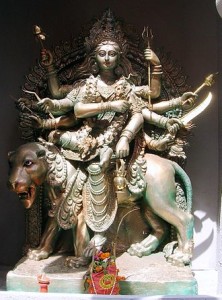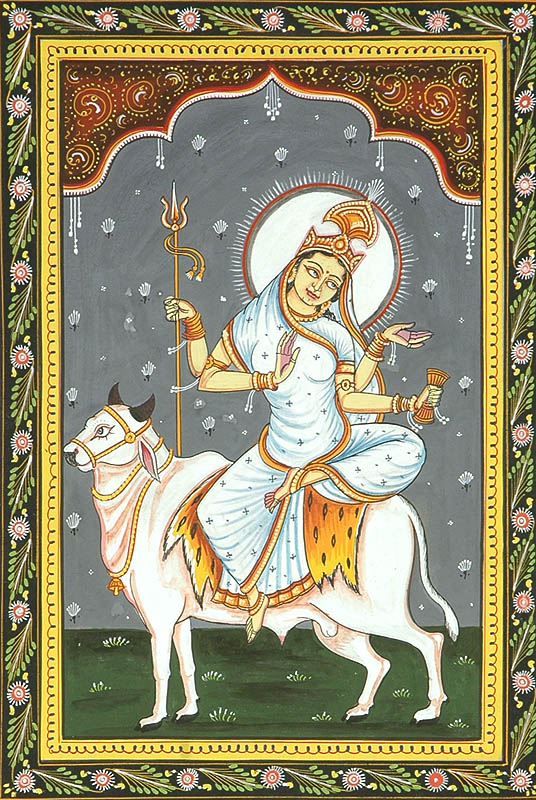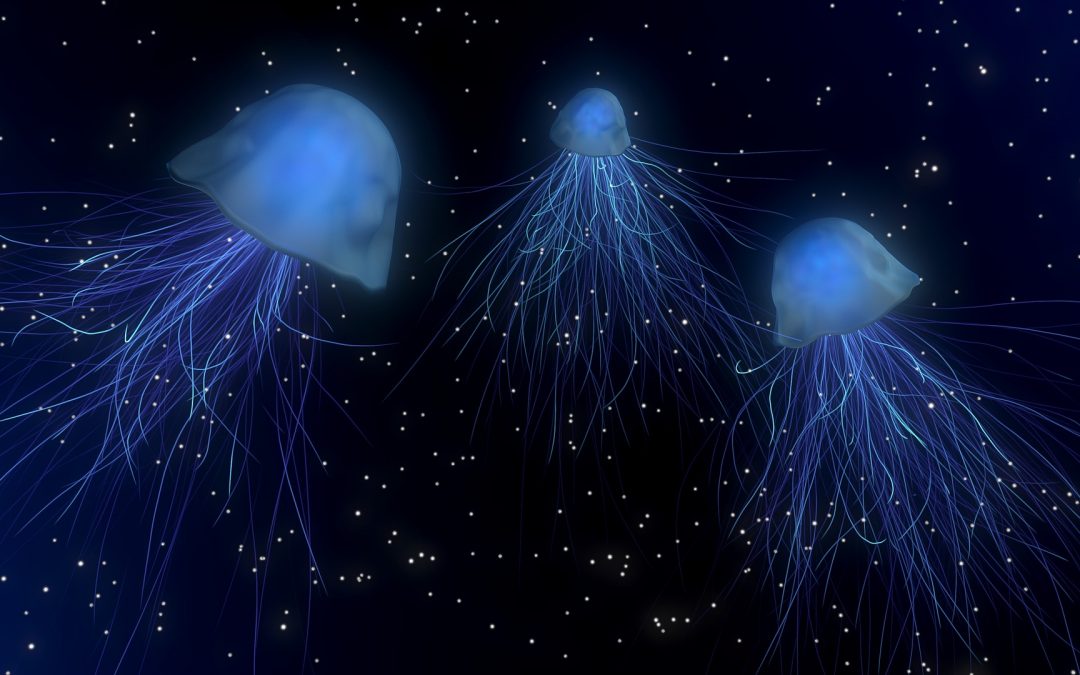
by Somya Devi | Apr 8, 2021 | Astrology, Conjunctions, Holy Days, Planets Changing Signs
New Moon April 2021
The Moon and Sun join to make a New Moon at the very end of sidereal Pisces at 10:31 pm ET on the dark night of Sunday, April 11th. This will begin a lunar cycle in which the Sun spends most of his time in Aries, his sign of exaltation. Jupiter, one of the outer, slower-moving planets, has transited into sidereal Aquarius, breaking rank with Saturn who remains in Capricorn.
Pisces-Aries Cycle
We enter another lunar cycle during which the Sun begins in one sign just two days before entering another, where he will spend most of the lunar cycle. Pisces is the last sign of the natural zodiac, the end, a place where we connect with the unseen world including the underworld itself. Aries, on the other hand, is a place of beginnings, the true springtime energy where the literal sunlight gives life to the world once again and things begin to grow outwardly. This cycle will connect these two worlds for us, bringing much of the subconscious into light as we begin to take on more activity during this season.
The Sun and Moon begin joined with a debilitated Mercury, which can make us pass up practicality in favor of hopes and dreams. Jupiter rules this femenine (inward-looking) water sign.
Revati Nakshatra
The Sun, Moon and Mercury are all in Revati nakshatra as we begin this Moon cycle. The final of the 27 Vedic nakshatras, this sign has to do with journeys, and is ruled by the deity Pushan, the protector of journeys, flocks and herds. We can imagine in particular the journey from life to death as this is the final journey that we all make. Revati means “the wealthy” and is also related to Mercury, Vishnu and Lakshmi. There is a strong association with animals and this nakshatra, and many people with planets here have a strong love of pets or animals.
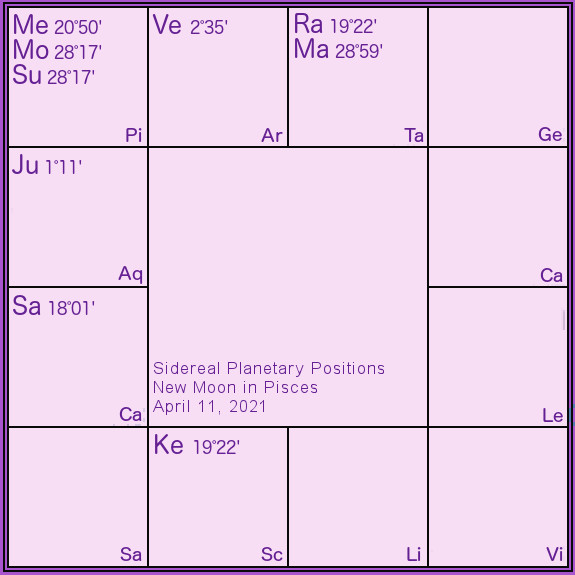
Jupiter Transit
Jupiter has moved from sidereal Capricorn into Aquarius, lightening his load as he is no longer in his sign of debilitation and joining the heavy presence of Saturn. Jupiter in Aquarius could stimulate some expansion in social programs, scientific innovations, and forward-thinking across society. This new position could stimulate some movement in your life depending on natal planetary positions and the current dasha (planetary period) and bhukti (sub-period) you are running according to your chart.
Mars Transit
Mars will leave Taurus just hours after the New Moon, finally parting ways with Rahu, lessening some of the intensity that has built up around their conjunction the past couple of months. His movement will also break the Kala Sarpa cycles, although with only one outlier the nodal alignment can still bring some intensity to current events or those born with these placements in the birth chart.
Chaitra Navaratri
This New Moon is followed by nine nights that are the springtime celebration of the goddess known as Chaitra Navaratri. These nights are celebrated in homage to the divine mother in her many forms, particularly Durga. This is not as largely celebrated as the fall-time Navaratri (Sharad or Maha Navaratri), but is also significant. This leads us up to Hanuman Jayanti which will be celebrated around the time of the next full Moon.
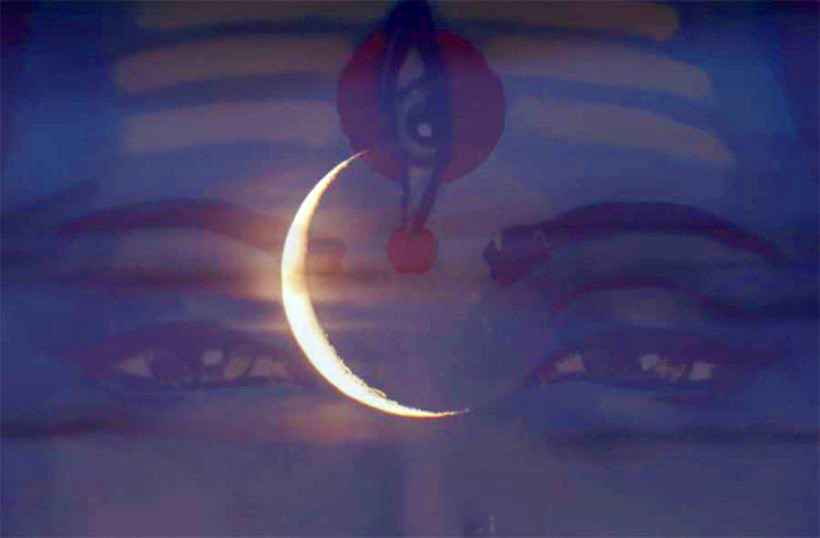
by Somya Devi | Mar 11, 2021 | Astrology, Conjunctions, Holy Days
New Moon and Maha Shivaratri, March 2021
The Sun and Moon join near the end of sidereal Aquarius on the dark night of March 12th, with an exact alignment under the New Moon at 5:21 am ET on Saturday, March 13th. Mercury and Venus also join the Moon and Sun in Aquarius, while Saturn (with Jupiter in sidereal Capricorn) once again rules over 6 grahas at the time of the New Moon. Mars and Rahu continue their conjunction in sidereal Taurus, opposite Ketu in Sagittarius, forming a Kala Sarpa Yoga in the sky. Thursday night, the fourteenth night of the waning Moon, marks the Maha Shivaratri celebration this month. Sun and Moon begin this cycle in the Vedic nakshatra Purva Bhadrapada, an auspicious sign for spiritual advancement.
Aquarius Cycle
With the new lunar cycle beginning in Aquarius, the coming month may have a quirky and forward-thinking tone, and we may see some scientific advances this month. The Mars Rover landing actually occurred just days after the Sun had entered its Aquarius cycle. Aquarius is in fact very much about service to the greater good. With Saturn strong in his own sign, we could see many significant advances in social support structures right now.
Aquarius is known as Kumbha in Sanskrit, a word for “pitcher” or “vessel.” According to the Vedic texts, the sign Kumbha can be imagined as a man holding a pot, with deep-brown skin, standing in the water. We can see this Aquarian imagery in the sadhus of India (and its biggest ritual pilgrimage day, the Kumbha Mela), who make their lives an offering of service to society through their prayers and Saturnian austerities, while renouncing the individual self. In the Aquarius cycle, we think about how we can serve the whole.
Maha Shivaratri
Thursday night, March 11th in North America, the night prior to the Dark Moon night, is the fourteenth waning phase of the lunar cycle. During this month this night is celebrated as Maha Shivaratri. This is the most auspicious night of the year for doing sadhana (spiritual practice). It is traditional on this night to stay up all night fasting, chanting, praying, and meditating. This holiday honors Lord Shiva, the great ascetic, as we recall two stories of great sacrifices that he made protect the entire creation.
One of these is the story of the gods and demons churning of the milk ocean in order to release the nectar of immortality. Before the nectar came up, however, a poison came up first. (This is similar to when we do spiritual practice and begin our path of self-inquiry, and negative tendencies often come to light first, which can be a painful experience. Similarly, during a physical fast or cleanse, toxins can be shaken loose and released first, causing a healing crisis before we continue healing into a freer, happier state of being.) When the poison came up from the milk ocean, Lord Shiva consumed it so that it would not engulf humanity, as a great and noble sacrifice. His wife, Parvati, however, held his throat so that he could not ingest it, thus saving him from being harmed by the poison.
Maha Shivaratri also commemorates the wedding of Shiva and Parvati, which also stemmed from great sacrifice made for the benefit of all humanity. It was said that after his first wife, Sati, perished, Shiva was fully devoted only to his sadhana, meditating for aeons in isolation and renouncing the world. Then the demon Tarakasura began running amock on earth, threatening all of humanity. Brahma foretold that only Shiva’s child could defeat Tarakasura, so the gods devised a plan for Sati to reincarnate as Parvati, and win over her Lord to marriage once again to produce this heir. Shiva was not easily swayed, however, and it was only after Parvati became an ascetic and underwent great penance that he agreed to marry. They eventually produced their son Kartikkeya, who went on to slay the demon.
Thus, this holiday is celebrated through the penance of fasting, forgoing food, water, and sleep, for one night, and simultaneously celebrating the union of Lord Shiva and Parvati, or the masculine and feminine energies of creation, that allows the dance of life to continue. It is an apt time to feel the forces of Aquarius upon us, which compel us to consider our role in society, and in the universe, and what personal sacrifices we can make for the greater good. Even if you’re not able to stay up the whole night, any amount of devotional practice, serviceful sacrifice, or chanting of Om Namah Shivaya on this night can have beneficial affects that are magnified greater than on any other night.
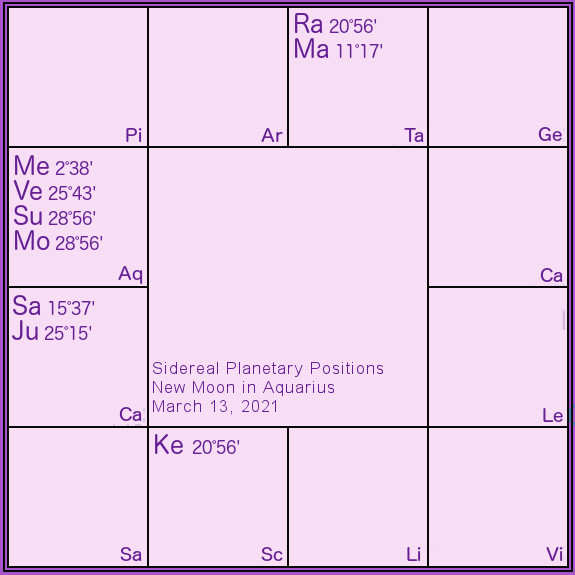
Kala Sarpa Yoga
This year’s Kala Sarpa yoga cycles continue, as Rahu and Ketu appear to cut the sky in half with all planets to one side of the nodal axis. Kala Sarpa can be translated as “black snake” or the “serpent of time,” and intensifies subtle forces on all levels, including inner challenges as well as strengths and yogic combinations in a chart. Mars joins Rahu in Taurus, and tho he will transit out of Taurus and into Gemini in one month, technically breaking the cycle, the intensity brought on by the alignment can sometimes continue when only one planet has crossed to the other side of the sky.
Purva Bhadrapada
The former “lucky-footed one” is the Vedic nakshatra (star-sign) where Sun and Moon begin this lunar cycle. This nakshatra bridges Aquarius and Pisces and is often represented by a funeral cot, symbolizing the transition from life into death, or ultimate liberation. It is ruled by Aja Epakada, the one-footed goat who is often associated with the image of Lord Shiva as Nataraj dancing on one foot, a fitting image for Maha Shivaratri.
Om Namah Shivaya!
Personal Chart Readings with Coaching Are Available Here

by Somya Devi | Sep 2, 2020 | Astrology, Conjunctions, Planets Changing Signs, Retrograde
Full Moon September 1st, 2020
The full Moon this cycle peaked at 10:22 pm PDT on September 1st, in sidereal Aquarius, opposite a Leo Sun. We continue to experience the Sun, Mars, Saturn, and Jupiter all strong in their own signs, with Jupiter aspecting both Mars and Sun to create some powerful energies across the globe. This offers many auspicious moments during the day for initiating certain activities (specific to your activity and location), but also keeps the fire element high in the atmosphere, sparking aggression or literal fires if we do not channel it into dharmic action.
Aquarius Full Moon
The Aquarius full Moon is the peak of the Leo cycle. This cycle started strong with the Sun in his home sign, inspiring us to let our inner power shine forth into activity. Power is often corrupt, however, and the fire of the Sun often burns, and we have seen an amplification of political vitriol, violence, and wildfires over the last two weeks.
The opposite of Leo is Aquarius, or Kumbha, “the pitcher.” This Saturn-ruled sign emphasizes service to society more than individual power. It is this service that is actually the higher manifestation of what we can do with that individual power. People in positions of leadership (Leo energy), including government authorities or the leaders of a family, have a responsibility to use that power to take care of others. While the full Moon is illuminated here, we can reflect on how to pour our power into the world in ways that benefit all, rather than keeping it for selfish or abusive means.
Shatabisha, Star of Healing
The Moon aligns with the Vedic nakshatra of Shatabisha, “the hundred physicians,” or “hundred medicines.” This star-sign encourages us to source all means of healing, physical, emotional and spiritual, drawing on our various inner and outer resources. We may find that it is an alternative healing method that yields the most progress for us. Its deity is Lord Varuna, god of the cosmic waters. Water medicine signifies cleansing, in a much more deep and gentle way than the purification by fire offered on the opposite end of the zodiac. It is a potent antidote to the firey energy of this month.
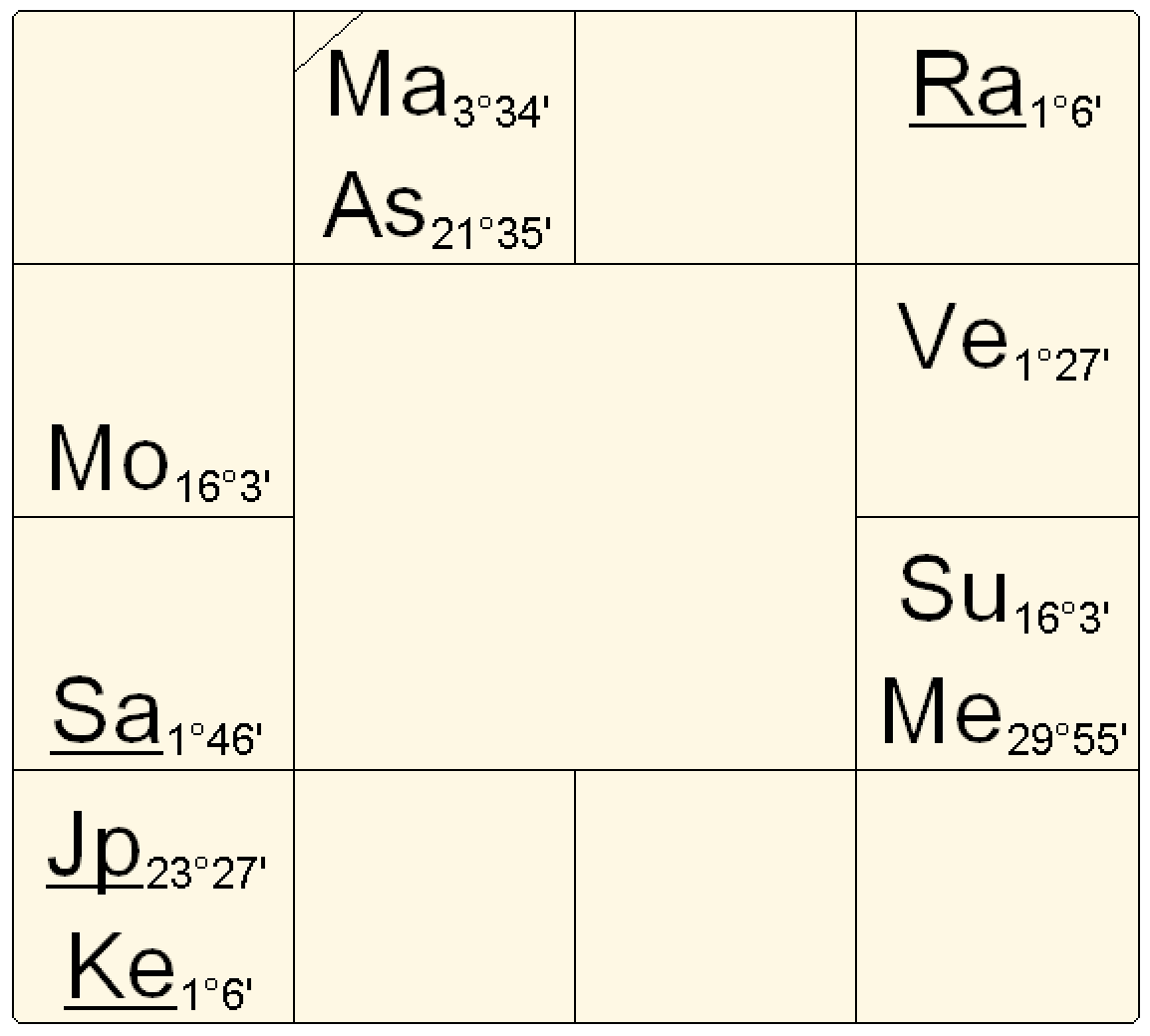
Mars and Jupiter, Retrograde/Direct
Mars and Jupiter are both slowing towards apparent stationary “stops,” as Mars prepares to turn retrograde on September 9th (through November 13th), and Jupiter prepares to turn direct on September 12th. These stationary dates add strength to both planets, as their reflected light shines directly at us in a very focused way. Within Aries, and amplified by Jupiter, this Mars could result in some explosive energy around the 9th, but also offers a lot of horsepower for launching a new venture. Philosophical movements, and clashes, could be high around the 12th as Jupiter stations and begins to move forward again.
Nodal Shift
The nodes, Rahu and Ketu, are nearing the end of their journeys through Gemini and Sagittarius, respectively. They will transit into the next signs, Taurus and Scorpio, on September 23rd (mean node calculation; it happens on September 19th using a true node calculation). This will shift the subconscious churning and “shadow work” that we need to do into a new area of life for the next year-and-a-half, also shifting the houses over which we will experience the eclipses during this time. This is a good time to check in with your own chart to see where this transit will be affecting you, personally.
To see how these transits affect and interplay with your chart and karma, you can request a personal reading here.
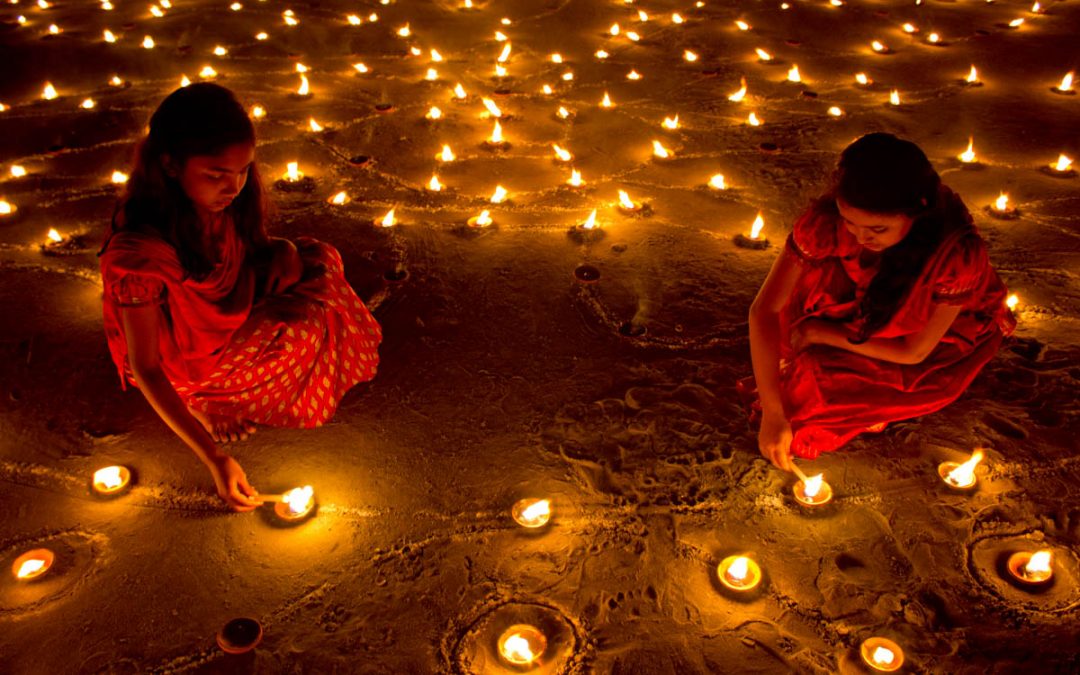
by Somya Devi | Oct 24, 2019 | Astrology, Conjunctions, Holy Days, Planets Changing Signs
The Sun and Moon will join at 10° sidereal Libra this Sunday night, October 24th, at 8:39 pm PDT. This Dark Moon night commemorates the Hindu holiday of Diwali, the festival of lights. October 27th will actually be the third but main night of celebration of this festival, which begins on Dhanteras on October 25th.
Libra cycle
The New Moon in Libra will begin a Libra cycle, compelling us to find balance, harmony, beauty, and compromise. Venus will have just left his own sign of Libra, a couple of hours before the New Moon, but has been strong there the last several weeks and during most of the Amavasya dark Moon phase leading up to the exact New Moon moment.
One thing to note about the Libra cycle is that the Sun is considered neecha or naturally debilitated there, so self-care becomes especially important during a Libra cycle. Since the Sun relates to our sense of strength and vitality, and Libra is the sign of compromising (or over-compromising) with others, it is possible that our own strength becomes diminished as we elevate the level of energy and attention we give to those around us. Caring for others doesn’t necessarily translate to depleted health, but it can when we overemphasize the outer world and others to the point of neglecting our own self-care.
This is a very important time of year to nourish ourselves, and our inner light, as the outer light is descending. At the beginning of this cycle, set an intention for a mindful self-care routine this month. Light some candles (or turn on your electronic ones) for Diwali on the Dark Moon night, and if possible, take some time each day to offer yourself some time to nourish and honor your personal light. Self-care practices can include yoga, meditation, chanting, art, or self-abhyangha (oil massage). You can also make some herbal tea to nourish yourself during this vata (cold and dry) season.
Swati Nakshatra
This New Moon joins the Sun in Swati nakshatra, a nakshatra that is also known to add to vata conditions, as it gives the power to scatter like the wind, so be aware of restlessness this Dark Moon night. It is ruled by Lord Vayu, wind embodied, and is symbolized by a young plant blowing in the wind, both flexible and strong amidst it. It can be translated as the “priest” or the “sword” and carries hidden spiritual potential from its association with Rahu. The male buffalo is the animal symbol for Swati nakshatra.
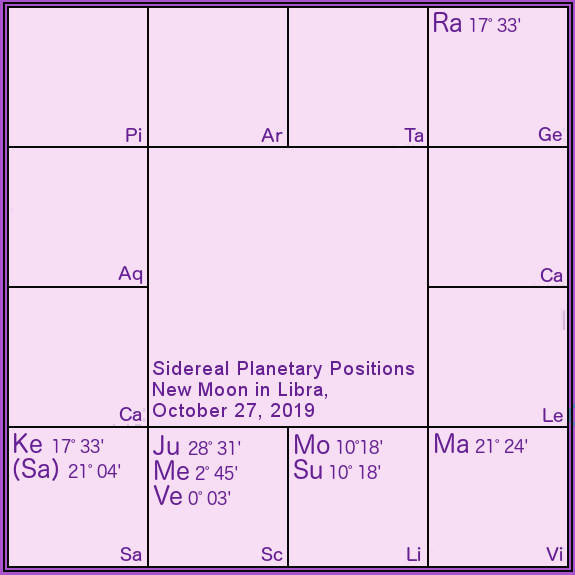
Venus, Jupiter and Mercury
These three benefic planets will be traveling together in sidereal Scorpio from October 26th through November 4th, when Jupiter transits into Sagittarius. The conjunction of these three planets creates a Sarasvati yoga during certain times of day, which could offer auspicious muhurtas (moments) for initiating artistic, educational or spiritual activities. If you were born with a Sarasvati yoga in your natal chart, you may find it more activated during these times.
Jupiter in Sagittarius
On November 4th, we will experience a major movement in the cosmos, as Jupiter transits from Scorpio into Sagittarius. Because the outer planets move slower, they spend longer in each sign, so this transit is important because it will take effect for over a year while Jupiter travels through his own sign. Generally that brings strength to a planet, but with the current conjunction with Saturn and Ketu, also in Sagittarius, we could see an intensification of strange and radical ideologies vying for their place on the world stage.
Dhanteras and Diwali
On the new Moon of the Hindu month of Ashwin (this month), we celebrate Diwali, the festival of lights. The festival begins this year on Friday, October 25th (North America), on the 13th waning Moon phase of the previous cycle. This day is known as Dhanteras, or Dhanvantari Tryodashi, the celebration of the birth of Lord Dhanvantari, the father of Ayurvedic medicine. If you practice any healing tradition, especially Ayurveda, this is a good day to give thanks and call in auspicious blessings to your healing path or practice.
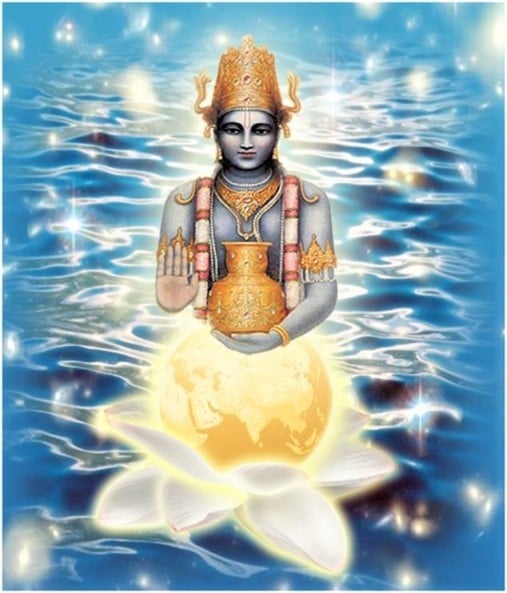
Diwali is strongly associated with the Goddess Laxmi, and is a powerful time to connect with her, calling in her blessings for both material and spiritual prosperity. Dhanteras commemorates the day that Lakshmi emerged from the milk ocean in Vedic lore. In India, it is customary to purchase metals on this day — anything from jewelry to new statues to kitchenware (excluding iron), especially silver and gold — as a part of celebrating Lakshmi and calling in more prosperity. The metals can then be offered to your altar and will absorb and amplify the benefits of worship performed over the few days of Diwali.
We celebrate Diwali while the days are getting noticeably shorter and darker, and it is a time to invite more light into our lives, our hearts, and our world. This festival celebrates the victory of light over darkness, which is something to rejoice in and have faith in, even if we can’t outwardly observe it sometimes. Creating positive vibrations internally is the best way to begin growing and spreading them externally.
Diwali also commemorates Lord Ram’s and Sita’s return from exile after fourteen years (a story from the Ramayana). Lord Ram embodies the highest qualities of dharma, devotion, compassion, courage, and leadership. Diwali is also the start of a new lunar cycle, so it’s a great time to go within and summon these qualities to awaken and live through you.
 Diwali (also seen as Divali, Deepawali or Deepavali) comes from the Sanskrit words deepa (light) and avali (row). It is traditional to light candles throughout Diwali (opt for electronic tea lights if you’re in a fire danger zone!), inviting the highest light into our homes and lives. The candles are lit to remind us of the inner divine light in us all. Though one flame can be used to light many others, it is not diminished by sharing its power of illumination. We can pray for the peace and happiness of all beings, and each one’s awareness of their inner light.
Diwali (also seen as Divali, Deepawali or Deepavali) comes from the Sanskrit words deepa (light) and avali (row). It is traditional to light candles throughout Diwali (opt for electronic tea lights if you’re in a fire danger zone!), inviting the highest light into our homes and lives. The candles are lit to remind us of the inner divine light in us all. Though one flame can be used to light many others, it is not diminished by sharing its power of illumination. We can pray for the peace and happiness of all beings, and each one’s awareness of their inner light.

by Somya Devi | Sep 27, 2019 | Astrology, Events, Holy Days
Maha Navaratri 2019 is upon us! In this important Hindu holiday, we celebrate the Goddess through “the great nine nights” (nav = nine, ratri = night). This festival will run from September 29th through October 8th, the first ten days of this new lunar cycle. Goddess, Devi, Shakti, Durga, Divine Mother—the many names and forms all represent the dynamic and fluid feminine power that enlivens all of existence.
She is the creatrix, the warrioress, the nurturer, the purifyer, the protector. While she’s in the innocent and fertile maiden so is she the wise and learned crone. Both the nurturing mother, and the one who gives “tough love.” The impassioned lover, the devoted bhakta, the disciplined yogini. We see Goddess appear through us in innumerable manifestations. Through her many forms she teaches us and offers us countless blessings–love, compassion, courage, learning, discipline, surrender, success, enlightenment, and bliss. This festival is a time for celebrating the supreme feminine power in all her glory, and the many blessings she bestows upon us.
As with most Hindu celebrations, this festival correlates with the lunar calendar, and thus begins on the first day of the waxing Moon after the New Moon of September 28th. The celebration is through the “nine nights” of September 29th through October 7th, and into the tenth morning known as Vijayadashami, “the day of victory.” Worship during Navaratri is most generally dedicated to Goddess in the form of Durga, the demon-slayer, but there is much nuance and variation to practice and forms of celebration throughout India. Above all, Navaratri is a community celebration of the Divine Mother, and the love, abundance and protection she gives.
There are many Navaratri celebrations throughout the year, but the fall-time Navaratri is the most widely celebrated, and is thus called Maha Navaratri – “the great nine nights”. It correlates with the time of the harvest, a time to give thanks for the abundance of the year’s work. Grains and crops are often offered to Devi as part of the celebrations. Ritualistic worship (puja) typically occurs in homes and temples throughout the nine nights and into the tenth morning of celebration.
The Many Forms of Goddess
Durga-Lakshmi-Sarasvati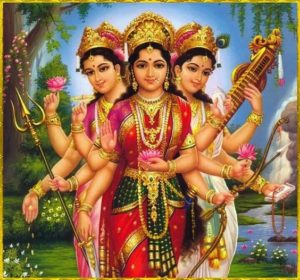
In Kerala and other places in India, the first three nights of worship are dedicated to Durga (the invincible), the next three to Lakshmi (Goddess of prosperity), and the final three to Sarasvati (Goddess of learning). Durga, also celebrated as her incarnation of Kali, helps us to destroy and remove the negative tendencies in our minds and hearts, freeing us from the obstructions to our spiritual and material pursuits. Lakshmi helps us to cultivate positive qualities like compassion and devotion, and leads us towards both spiritual and material prosperity. Sarasvati assists us in attaining knowledge and wisdom, through the illumination of our consciousness. She aids in awakening sattva, the quality of purity, and the flow of prana, the vital breath. After removing inner and outer obstacles and cultivating prosperity through virtuous qualities, our devotion, service, and practice help us to attain a state of peace, bliss, and oneness.
Sarasvati-Lakshmi-Kali/Durga
In the Kali Kula (Kali school of worship) in northeastern India, Sarasvati is worshiped on the first three nights, followed by Lakshmi on the next and then Kali/Durga on the last three. Sarasvati, Lakshmi, and Kali/Durga (Kali emerged from Durga) are also known as the consorts of Brahma, Vishnu, and Shiva. The Goddesses, therefore, provide the shakti to the cosmic processes of creation, preservation, and death (transformation), similar to their male counterparts. Consequently, worship in this manner is dedicated to the cycles of life and Mother nature, through birth, then sustenance, then death. Death is not a complete stop, but allows for the regeneration of energy into a new cycle once again.
9 Forms of Durga
Throughout India, the nine nights of Navaratri are often dedicated to 9 different incarnations of Durga, allowing the worship of many different aspects of Shakti in a gradual evolution. You can read the stories and significance of these 9 goddesses here, or a more a brief introduction, here:
“Daughter of the mountain”; creative energy, muladhara (root chakra), awakening; Awaken your connection with Goddess today or initiate a new venture, calling on Shailputri for new beginnings.
The ascetic; tapas, discipline, devotion, strength, wisdom, creative abundance; Good day for fasting and meditation, connection with svadhistana (sacral chakra).
Warrioress; protection, courage, grace, manipura (solar plexus); Destroy your internal obstacles by offering them to Chandraghanta.
Creatrix of the “cosmic egg”; strength, health, happiness, success, relationships; Connect with the vital Sun energy and the anahata (heart chakra) today.
“Mother of Skanda/Kartikeya”; motherly love, nourishment, protection, purity; Call on divine truth through the vishuddha (throat chakra), invoking Skandamata to lead you towards victory.
Warrioress who destroyed Mahishasura (the buffalo demon); victory, devotion, strength, removing obstacles; Meditate on these qualities of Goddess through the ajna chakra (third-eye) today.
“Dark/black night,” representing a fierce form of Durga/Kali; darkness, death, surrender, dissolution of pain; Connecting with the sahasrara (crown chakra), remember that Divine Mother offers love, compassion, and many blessings even in hard times. Even in the midst of apparent darkness, and helps us to go beyond the boundaries of the material body-mind and connect with spirit.
“Great white goddess”; detachment, purification, renewal, protection, virtue; Through detachment and devotion, we emerge purified, shining and radiant after surrendering in the dark night. Rejuvenative herbs and foods are good today.
Goddess of “siddhis”; magical, spiritual or mystic powers and blessings, fulfillment of desires, devotion, divine union; Invite Goddess to reveal her presence to you everywhere and in every moment.
Personal Practice Ideas for Navaratri
If possible, it is great to reduce our workload and gather with community at local temples or places of worship. We can also create a little time and space at home and conduct some personal practices to celebrate Goddess energy. Dive into your own heart to connect with the inner Goddess in the ways that resonate most with you! Here are some ideas to do at home or with a group throughout the nine nights of Navaratri:
Altar
Create a sacred space, a Durga altar, or a Goddess altar. Even if you already have one, you can refresh it in some way or rearrange it specifically for Navaratri. Include images or statues of the Goddess(es) you have a relationship with. This could be according to one of the groups of forms above.
Invocation
Even if you don’t have much time, dedicate at least a few minutes each day to connecting with the Divine Mother in front of your altar, calling her energy into your life and being.
Journal
Write in your journal about what qualities of Goddess you perceive and connect with. What aspects would you like to strengthen or to cultivate more deeply? Write any and all prayers and offer them to the form of Goddess that appeals to you.
Light
Offer light to illuminate Goddess’s power, helping her to shine more brightly into the world and your life. You can light a candle by the altar and keep it burning when you’re at home. You can even keep an electronic tealight on symbolically when you are away.
Flowers/Grains
Offer flowers or grains (even a small dish of dried rice) to celebrate Devi in the form of mother nature, fertility, the abundance of the harvest, and the cycle of life.
Offerings
Offer incense, bells, water, or food if you feel called, by placing it on the altar, or mentally offering it to Goddess throughout the day. You can also offer something symbolic of your own work or practice, whatever you have been cultivating for harvest through the year. In offering this you surrender the fruits of your efforts to the Divine Mother.
Fasting
Some people choose to fast in some variation, if this is something you have practiced before. This might include fasting during the day, fasting with only milk or fruit, or abstaining from alcohol and non-vegetarian foods during Navaratri.
Chanting
Chanting the Devi Mahatmyam, a verse to the Goddess, is a common practice during the nine-night festival. You can also chant another Goddess mantra or songs that are special to you and your relationship with Devi.
Jai Ma Durga!
Personal Vedic Astrology readings and forecasts are available Here.
Did you like Maha Navaratri 2019? Please Like, Comment and Share!













